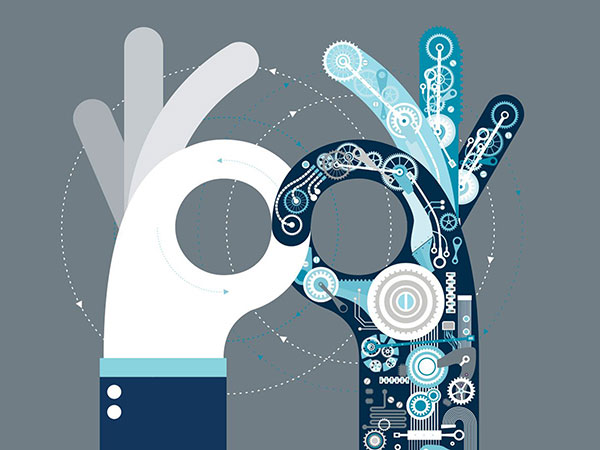Technology has undoubtedly reshaped almost every part of society, changing how people communicate, travel and live, among other things. It also upended processes and practices in the manufacturing sector, including through these advancements.
Artificial intelligence can reduce unplanned downtime
It wasn’t long ago that artificial intelligence (AI) was something the mainstream public only knew about through science-fiction films and books. They’re now more familiar with it because AI is more accessible and starting to influence all parts of society.
The opportunities to use AI in manufacturing are seemingly limitless. One practical application is to deploy a predictive maintenance solution that gauges the likelihood of a single part of an entire machine failing and shutting down production. An AI-based system can warn factory managers of the need to schedule repair appointments before it’s too late.
Before that option existed, issues typically only became apparent once a piece of equipment started having problems, such as not starting up at the beginning of the workday. Predictive maintenance, on the other hand, can detect minute changes in functionality. It can also extend the remaining useful life (RUL) of a machine by sending alerts as soon as it’s time to set up a service call.
Unexpected downtime can cost hundreds or thousands of dollars per minute, depending on what are manufactured at a plant. Moreover, depending on the role a broken machine plays in making products promptly and how soon a technician can fix the problem, a breakdown could substantially impact a company’s ability to remain profitable. Predictive maintenance using AI algorithms can help manufacturing businesses respond more proactively.
Additive manufacturing can create products faster and with less expense
Additive manufacturing, also known as 3D printing, involves using a computer to specify the necessary design details about an item, then instructing a specialized printer how to operate and make the product. The printer usually deposits material layer by layer, gradually creating three-dimensional results.
This method already shows incredible promise, especially for getting things made more efficiently and at a lower price point. 3D printing also makes products available to people who formerly couldn’t access them due to living in rural areas. One hospital in Guatemala uses a handheld portable scanner to generate the files that 3D printers need to work.
Before 3D printing arrived, prosthetics were too expensive for many people who needed them, and the process took weeks, requiring many appointments. Digitizing the approach with help from additive manufacturing increases patient access, plus cuts down the overall expense.
3D printing also enables manufacturers to print extra parts for their equipment. That option is especially convenient if it might otherwise take several weeks before a piece comes in stock and gets shipped. Jeannette Song, a professor at Duke University, built a mathematical model that assists manufacturing companies in deciding which parts to keep readily available on-site and which to 3D print when needed. Her model shows that even when manufacturers don’t use 3D printing to take care of their extra parts requirements very often, they save massive amounts of inventory.
Now, it’s no longer necessary to keep lots of parts available, but taking up space when the plant might not ever use them. 3D printing also enables a manufacturer to take more control of its parts needs without relying on outside suppliers.
Data-gathering helps manufacturing companies have enhanced visibility
Most manufacturing companies have collected data for a while, but the process for doing it was extremely segmented. If a plant manager wanted to compare performance between two facilities in different states, they’d have to contact people at each location and request information such as quarterly reports or weekly spreadsheets.
The time and effort required to find and compile the data often meant that the people needing the information might not have it for months. The individuals preparing it may have to communicate with employees in multiple departments while carrying out the research. Things are different now, and that’s primarily due to the Industrial Internet of Things (IIoT) concerning connected equipment.
IIoT sensors are internet-enabled and collect data in the background throughout a workday. Then, they automatically send it to a software-based interface — often one that functions in the cloud. Manufacturers use the IIoT in a wide variety of ways, but one of them is to enjoy better visibility into the lifecycle of a product. Then, companies can ensure the items they make are high-quality and will last as long as customers expect.
Data-gathering can also help manufacturers pinpoint what’s going wrong after customers receive products. For example, a company could use a database to capture all the instances of people making warranty claims or repair requests. Then, it could investigate further and uncover any commonalities about those events. It may become apparent that a particular part is most likely to break.
This boosted visibility can also lead to process improvement. In one case, a company that mined precious metals scrutinized its data to determine which factors had the biggest impacts on yields. It used the resultant conclusions to make small changes that caused a 3.7% increase in average yield within only three months. Modern technology supports facilities in acquiring data, analyzing it and making beneficial changes much faster than older methods allowed.
Collaborative robots safely boost production rates
Before robots were available for manufacturers to invest in, companies had no choice but to hire more people and increase the number of shifts to raise production levels and keep clients satisfied. When the industrial sector initially beefed up its workforce with robots, the machines stayed behind barriers or surrounded by cages to protect humans.
Starting in 2008, however, the first collaborative robots — more frequently called cobots — arrived. Those are smaller, comparatively lightweight and equipped with sensors that make the machines stop moving when people get too close. These features mean employees can work alongside cobots on the factory floor without sacrificing safety.
Grand View Research anticipates a 44.5% combined annual growth rate for the cobots market from 2029-2025. That forecast shows companies are getting on board with this technology and are eager to see what it could do for them. Cobots excel at tasks such as handling or assembling materials. Also, these machines don’t get tired like humans, so they can maintain consistently reliable performance.
Toolcraft Inc, a precision machining shop, needed to automate a multistep process to satisfy the needs of a medical device client. It tasked a collaborative robot with securely inserting a part into a computer numerical control (CNC) fixture. This approach also integrated a pneumatic gripper with the cobot to suit specific steps in the process.
After making the cobot part of its production, the facility saw a 43% increase in throughput, plus went from producing 255 pieces per week to 370. Once Toolcraft Inc. used the robot for six months, costs went down by 23%, and the company anticipates a return on investment in approximately one year.
Technology will continue to help the manufacturing sector progress
People in today’s society increasingly expect manufacturers to cater to them without delays. They also have little patience for faulty or low-quality products. These examples show that technology has already helped the manufacturing industry thrive. People should look forward to these and other technologies having similarly positive impacts for the foreseeable future.
























